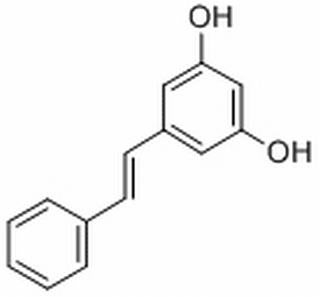Home
Products
Pinosylvin



| Product Name | Pinosylvin |
| Price: | $103 / 10mg |
| Catalog No.: | CN04074 |
| CAS No.: | 22139-77-1 |
| Molecular Formula: | C14H12O2 |
| Molecular Weight: | 212.3 g/mol |
| Purity: | >=98% |
| Type of Compound: | Phenols |
| Physical Desc.: | Powder |
| Source: | The herbs of Pinus yunnanensis |
| Solvent: | Chloroform, Dichloromethane, Ethyl Acetate, DMSO, Acetone, etc. |
| SMILES: | Oc1cc(/C=C/c2ccccc2)cc(c1)O |
| Contact us | |
|---|---|
| First Name: | |
| Last Name: | |
| E-mail: | |
| Question: | |
| Description | Pinosylvin is a pre-infectious stilbenoid toxin isolated from the heartwood of Pinus spp, has anti-bacterial activities[1]. Pinosylvin is a resveratrol analogue, can induce cell apoptosis and autophapy in leukemia cells[2]. |
| In Vitro | Pinosylvin (0-100 μM; 24 hours) is cytotoxic to THP‐1 and U937 cells, exhibits an IC50 value of 20-30 μM in leukemia cells, the maximal cytotoxic effect occurred at 100 μM following incubation for 24 hr[3]. Pinosylvin (0-100 μM; 24 hours) enhances the number of annexin V+ and PI+ cells in the U937 population at 50 μM, increases annexin V+ and PI+ cells in the THP‐1 population at 100 μM[3]. Pinosylvin (0-100 μM; 24 hours) promotes autophagy in leukemia cells by enhancing the level of LC3‐II and p62/SQSTM1 degradation in leukemia cells[3]. Cell Viability Assay[3] Cell Line: Leukemia cells Concentration: 0 μM; 0.1 μM; 1 μM; 10 μM; 50 μM; 100 μM Incubation Time: 24 hours Result: Was cytotoxic to leukemia cells at high concentrations. Apoptosis Analysis[3] Cell Line: U937 and THP‐1 cells Concentration: 0 μM; 0.1 μM; 1 μM; 10 μM; 50 μM; 100 μM Incubation Time: 24 hours Result: Induced apoptosis cell number in U937 and THP‐1 cells. Western Blot Analysis[3] Cell Line: U937 and THP‐1 cells Concentration: 0 μM; 0.1 μM; 1 μM; 10 μM; 50 μM; 100 μM Incubation Time: 24 hours Result: Induced autophagy in leukemia cells. |
| In Vivo | Pinosylvin (intravenous injection; 10 mg/kg) yields the plasma AUC, urine t , CL and Vd values of 5.23 ± 1.20 mgh mL-1, 13.13 ± 2.05 h, 1.84 ± 0.44 Lh-1kg-1 and 2.29 Lkg-1, respectively in male Sprague-Dawley rats, in a PK study[1]. |
| Density | 1.3±0.1 g/cm3 |
| Boiling Point | 397.6±17.0 °C at 760 mmHg |
| Flash Point | 194.9±15.5 °C |
| Exact Mass | 212.083725 |
| PSA | 40.46000 |
| LogP | 3.68 |
| Vapour Pressure | 0.0±1.0 mmHg at 25°C |
| Storage condition | 2-8°C |